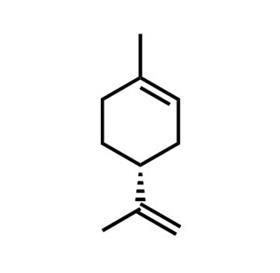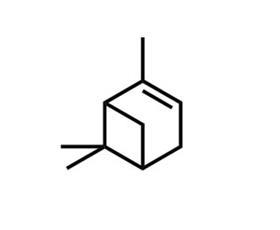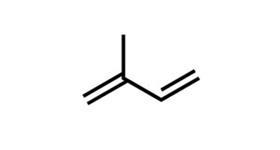VOCs are more than just a man-made problem. Anthony King looks through the wood to the trees
The aroma of a pine forest on a warm summer day is down to volatile organic compounds (VOCs). Cedar, cypress and eucalyptus owe their pungent aromas to their unique blends of these organics. With climate change, we are set for more VOCs and a more fragrant world.
Well known natural VOCs include limonene in citrus, linalool in lavender and pinene in pine, but over a thousand are known. One compound – isoprene, C5H8 (2-methyl-1,3-butadiene) – has stood out to researchers due to the sheer quantities produced and its reactivity. ‘Because of its high chemical reactivity, it is responsible for driving a lot of the chemistry of the lower atmosphere,’ says Nick Hewitt, an atmospheric chemist at Lancaster University in the UK. ‘And in particular the chemistry that leads to ground level ozone and also secondary organic aerosol (SOA) formation.’ Ozone is a powerful respiratory irritant linked to increased hospital admissions for respiratory problems; children and the elderly are at particular risk. SOAs can deposit in the lung and cause lung, heart and other health problems.
Predicting VOC emissions and influence is much more complex than thought – this can be affected by seasons, weather, differences between and within species, and by stress and disease.
VOCs pops
Isoprene is the most important non-methane VOC, with over 500 million tonnes released naturally every year, and it appears to protect plants against heat stress. It also reacts with NOx to produce ozone and other pollutants, harmful to human health but also plants. Isoprene sports two unsaturated groups and reacts readily with hydroxyl radicals, the foremost oxidant in the lower atmosphere. Because of its reactivity and ubiquity, isoprene acts as a control on the level of hydroxyl radical concentrations and so affects the removal of almost all gaseous pollutants.

There has been a big switch in how atmospheric chemists view isoprene. ‘Maybe 15 years ago the assumption was that isoprene doesn’t form secondary organic aerosols because all its products are too volatile,’ says Allen Goldstein at the University of California, Berkeley, in the US. Just a few percent of the isoprene produced becomes SOAs, but there is so much that it makes a significant contribution over forested and nearby regions.
‘The amount of aerosols that are formed from isoprene depends on the anthropogenic pollution that is present at the same time,’ says Goldstein, who has recently studied this phenomenon in the southern US and in the Amazon. ‘NOx, sulfur dioxide and black carbon, all from anthropogenic sources, actually change the fate of the naturally emitted isoprene and cause a higher rate of secondary aerosols to be formed.’ Put warmth, sunlight, isoprene and NOx together, and air quality will plummet.
It is not all about air quality. The atmospheric transformations of isoprene and other VOCs can lead to the formation of SOAs, which affects climate in two ways. SOAs influence climate directly by generating a haze of particles, which can absorb and scatter sunlight.
These aerosols can also act as condensation nuclei, encouraging the formation of more clouds and increasing the optical thickness of individual clouds. This effect could be ramped up further with global warming – more VOC emissions could mean more clouds. This also reduces the amount of solar radiation reaching the surface, causing a net cooling effect. But the buzzword for VOCs and climate is uncertainty. Isoprene emissions are likely to rise with global warming, removing more hydroxyl radicals. This could also amplify into more warming, because hydroxyl removes methane, a potent greenhouse gas.
It is uncertain whether increased VOC emissions will cool or warm the climate, as it depends on the relative weights of all these effects. Work is continuing on the quantities of VOCs emitted, what happens once they are in the atmosphere and how all this might impact climate models. But a warmer world will almost certainly be a more fragrant world, with more isoprene and other VOCs.
‘Isoprene emissions increase roughly 10% for every degree Celsius increase,’ says Goldstein. ‘A one degree temperature increase may be the equivalent of total anthropogenic emissions [of carbon compounds] today.’ But plants, which increase VOCs in response to stress, must be factored in.
Isoprene is the building block for other VOCs within plants: two isoprenes for monoterpenes (C10H16), three for sesquiterpenes (C15H24). These terpenes are the main ingredients of plant essential oils, and their complexity, high molecular weight and lower vapour pressure make them even more likely to adhere to particles.
Smells like trees’ spirit
A woodland bouquet may consist of hundreds of VOCs, but only at the parts per billion or trillion level, making detection tricky. Satellites cannot pick them up. Advances in analytical methods are delivering surprises and cutting out some uncertainties.
Benzenoids are part of many floral scents, but the assumption was that most of those detected in forests were man-made. ‘Most benzenoid compounds really have been neglected or assumed not to be important as biogenic emissions,’ explains Hewitt.

Then, in 2015, Hewitt and colleagues revealed that atmospheric benzenoid emissions from plants rival those from fossil fuels. Inventories underestimate them, which matters because these aromatic compounds produce high levels of aerosols – a yield of 20% is typical for forested regions low in NOx, compared to 2% for isoprene. Biogenic benzenoids are likely to produce SOAs at a rate of about 10 million tonnes per year, which is comparable to the SOA formation rate from man-made benzenoids, according to the study. This matters because of their role in cloud formation and the energy balance of the atmosphere.
More surprises are likely. 90% of all organic emissions entering the atmosphere come from natural sources. Plants, especially those under stress, emit hundreds of individual organic compounds, and measuring them is a huge analytical chemistry challenge. They can then react in the gas phase with oxidants like hydroxyl radicals during the day, nitrate radicals at night or ozone at any time.
During the day, hydroxyl radicals dominate the reactions, says chemist John Wenger at University College Cork in Ireland, who studies isoprene reactions with hydroxyl in atmospheric simulation chambers. ‘In the presence of air, we get several tens of reaction products from that one molecule alone,’ he explains. As oxidation proceeds, molecules increase in size and vapour pressure declines; eventually they partition into particles, forming SOAs.
This is a hot research topic, says Wenger. ‘But it presents analytical challenges because it is a mixture of gas phase and particle phase products.’ Greenhouse gases are understood; particles, not so much. ‘They have variable composition and therefore their properties are also variable. And they are not emitted directly, but there is a complex chain we must follow,’ Wenger adds.
Thankfully instrumentation to measure organic chemicals in the atmosphere has rapidly advanced in the last decade. New mass spectrometry techniques, using chemical ionisation, ultra-high resolution and time-of-flight detection, have provided many improvements in the identification of both gaseous and particle-bound organics in the atmosphere. ‘It is challenging because as they get more oxidised they get stickier and potentially more unstable, and can react to form larger compounds,’ says Goldstein, who has spent much effort on improving collection techniques.
Stress test
In the northernmost part of Finland, plant scientist James Blande, of the University of Eastern Finland, smells the volatiles coming off mountain birch forest with a rhododendron understory. ‘The volatiles emitted by the birch trees include monoterpenes, green leaf volatiles [cut grass smells] and sesquiterpenes, with trans-beta-caryophyllene the most abundant volatile,’ says Blande. Sesquiterpene, used in perfumes, fills the air especially if the trees are damaged.
Temperature increases will lead to insect outbreaks, which will have an impact on VOC emissions in forests
Tread on the rhododendron shrub as you walk and you smell other volatiles, including the sesquiterpene ladene and sesquiterpene alcohols ledeol and plaustral. Many are in the business of plant defence and are toxic to insects that eat the plants or lay eggs on them. Plants emit volatiles after herbivore damage to attract their natural enemies and signal to other plants about stresses such as heat, waterlogging or physical damage. Others have antimicrobial properties.
Plant stress can transform atmospheric chemistry and tip into a domino effect on clouds, haze and oxidant levels. Studies in lodgepole pines and Engelmann spruce in the US revealed that VOC profiles alter after infestation with mountain pine beetles. The trees in Colorado released as much as 21 times more VOCs when infected and switched to heavier, more complex VOCs than pinene; the result was more aerosols and potent precursors to SOAs. Modelling suggested insect infestation could ultimately impact climate, as ripples from the beetles blanket millions of hectares of the US and Canada.
‘Temperature increases in the boreal zone will lead to insect outbreaks, which will have a substantial impact on VOC emissions,’ Blande predicts. This would reinforce any VOC rises from warming. If man-made emissions like NOx are present, one outcome is more ozone pollution and poorer air quality. ‘Ozone is known to negatively affect plant performance and the effects on crop yields globally have been estimated at several billion US dollars,’ adds Blande.

Isoterpene and monoterpenes may protect against oxidants by reacting with them, but could volatile signals be overwhelmed in some situations, leading to poorer plant health? Blande’s research partly focuses on this question of whether ozone could jam plant signaling.
In southern Estonia, plant scientist Ulo Niinemets, at the Estonia University of Life Sciences, carries out lab studies and collaborates with field scientists in the Jarvselja experimental forest, a mix of spruce and birch. He believes that volatile emissions are far more dynamic than assumed. Some plants regularly emit certain VOCs, but others ramp up in response to stress. Norway spruce sends out waves of limonene when infested by spruce spider mite, for instance.
‘Every plant can emit volatiles under certain stress conditions. This is why we have vastly underestimated the emission potential of vegetation,’ says Niinemets, who heads up a European Research Council project on this topic. While oak is a strong emitter of VOCs, once herbivores arrive it changes its blend, dampening down on isoprene and ramping up sesqueterpenes such as pleasant smelling caryophyllene. This is a larger, more complex compound than isoprene and is even more likely to adhere to particles and lead to SOAs.
Niinemets says we need quantitative data on plants and how it is impacting aerosol formation. We know that some species are stronger emitters of certain VOCs. Maple, hazel, holly and English oak are low isoprene emitters; willow, poplar and birch are all high emitters. ‘You might make a decision about which trees to plant in response to that information,’ says Hewitt, since isoprene emitters in urban areas generate ozone smog if NOx is coming from cars. He has reported that some trees, such as black gum, English oak and poplar, are detrimental in terms of urban air quality.
There seems to be a long road ahead before the data going into climate models on VOCs and aerosols is near complete. This is the message from field and lab scientists. Across the Baltic, Jaana Back found that individual stands of Scots pine trees emit different blends of VOCs. ‘It is an inherited property and cannot be changed over a tree’s lifetime,’ explains Back, a professor of forest–atmosphere interactions at the University of Helsinki, Finland.
‘The blend of compounds is very specific for individual trees, individual ecosystems and times of the year, so it is a very dynamic exchange of compounds between ecosystems and the atmosphere,’ says Back. In 2014, she found that new foliage growth is a significant and unaccounted source of volatiles in boreal evergreen forests. Growing foliage is high in sugar and nutritious for herbivores; Scots pine triple their monoterpenes in growing needles, and springtime buds contain around 500 times more VOCs than mature needles.
Shifting landscapes
Plant scientists throw two more complications into the ring. Predicted global warming should mean more biomass, and this should translate into more VOCs. Back says that this should mean more aerosols to diffuse light, and photosynthesis operates better under such light conditions. The result: yet more growth in a warming world. On the other side of the ledger, elevated CO2 has an inhibitory effect, so may push emissions down, and falling man-made sulfur dioxide releases should dampen aerosol formation.

All this makes modelling aerosols and cloud formation that bit harder. And aerosol predictions and feedback on climate change are already some of the most intricate parts in models built to project future climate scenarios.
But what if the biosphere is itself changing and producing different VOCs? Tropical rainforests produce relatively low amounts of isoprene, but this landscape is being changed in Africa, Asia and South America. Cutting down the forests and replacing them with something like palm oil plantations, as is happening in Malaysia and Indonesia, shifts the chemistry in the skies above. This influences air quality and potentially climate.
‘Oil palm trees produce very high amounts of isoprene, which is reactive and contributes to ozone. Where oil palm trees are replacing rainforest, this will mean more isoprene and potentially more ground-level ozone,’ says Hewitt. He recently discovered that poplar plantations in Europe can have the same influence on ozone and linked certain poplar cultivars with ozone and premature human mortality.
Where this matters most, in terms of air quality, is where a forest and city interact. At the borders between the two, VOCs from the forest may flow into NOx streams from the urban area. Strong atmospheric chemistry is likely, especially in the presence of sunlight and high ground level ozone.

‘What that tells me is you have to be extra careful to control NOx emissions in those areas,’ says Hewitt. California’s big city air colliding with fragrant forest air in strong sunlight is ideal for ozone smog and the same situation may occur in the tropics.
‘There is uncertainty in the emissions, there is uncertainty in the chemistry, there are uncertainties in the properties of the particles, which leads to uncertainties in cloud formation,’ says Wenger. ‘All this is magnified by the time it gets into a climate model.’
The science of VOCs is full of unknowns, leaving no shortage of work ahead for atmospheric chemists. We’ve gone from considering VOCs as wasteful to realising just how interesting and puzzling they are in the bigger picture. But it is likely that levels of fragrant volatiles will rise in a warming world, so until climate models get a handle on their future effects, we’ll just have to enjoy the aroma.
Anthony King is a science writer based in Dublin, Ireland













No comments yet